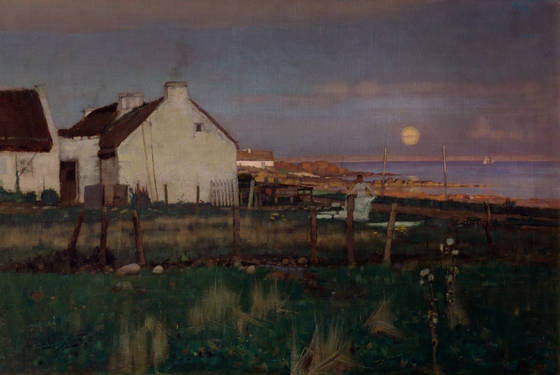Pioneering Painters
dal 29/10/2010 al 22/1/2011
Segnalato da
29/10/2010
Pioneering Painters
Royal Academy of Arts, London
The Glasgow Boys 1880 - 1900. The exhibition features over 80 oil paintings, watercolours and pastels from public and private collections by such artists as Guthrie, Lavery, Melville, Crawhall, Walton, Henry and Hornel. Together they presented a new art, which had a major impact at home and abroad in the closing decades of the nineteenth century. Taking inspiration from such French Naturalist painters as Bastien-Lepage and also from Whistler, the Glasgow Boys produced some of the most revolutionary painting in Britain, drawing praise in London, Munich, Vienna and further afield.

In October 2010 the Royal Academy of Arts will present the first exhibition in London for over 40
years to celebrate the achievement of the Glasgow Boys, the loosely knit group of young painters
who created a stir at home and abroad in the final decades of the nineteenth century. The
exhibition will feature over 80 oil paintings, watercolours and pastels from public and private
collections by such artists as Guthrie, Lavery, Melville, Crawhall, Walton, Henry and Hornel.
Together they presented a new art, which had a major impact at home and abroad in the closing
decades of the nineteenth century. The resultant works were, from c. 1880 to 1900, among the
most experimental and ambitious to be produced in the UK.
Taking inspiration from such French Naturalist painters as Bastien-Lepage and also from
Whistler, the Glasgow Boys produced some of the most revolutionary painting in Britain,
drawing praise in London, Munich, Vienna and further afield. Their symbolist pictures were
admired and emulated in secessionist circles in Germany and Austria.
The exhibition maps the Glasgow Boys’ responses in both subject matter and technique to
developments in art which were taking place in Paris in the 1870s and 1880s. These artists
sought to liberate their art from the staid, dark toned narrative paintings being produced in
Glasgow and Edinburgh in order to explore the effects of realist subject matter and the particular
effects of light captured through working out of doors, directly in front of the motif.
The subject matter of the works is largely scenes from rural – mainly Scottish – life, including
studies of individual figures, such as James Guthrie, To Pastures New (1882–3) and The Hind’s
Daughter (1883), George Henry, Noon (1885) and Edward Arthur Walton, A Berwickshire
Fieldworker (1884). Landscapes include the striking Autumn in Glencairn (1887) by James
Paterson and A Galloway Landscape (1889), by George Henry. A significant group of works also
record modern urban life, including John Lavery, The Tennis Party (1885) and William Kennedy,
Stirling Station (1887).
Another group shows the impact on artists such as John Lavery, William
Kennedy and Arthur Melville of their experience of working in France at Grez-sur-Loing, a
picturesque village to the southeast of Paris which attracted an international community of
artists. The exhibition closes with a section presenting the legacy of the Glasgow Boys in the
early twentieth century as it was defined by only a few of the members of the group, notably
Lavery and Guthrie as portraitists, and by the short-lived Melville, who was a supreme
experimenter in image making and technique, both oil and watercolour.
Pioneering Painters: The Glasgow Boys 1880 – 1900 is an exhibition from Glasgow Museums in
association with the Royal Academy of Arts. The exhibition has been curated by Jean Walsh,
Senior Curator, and Hugh Stevenson, Curator of British Art, Glasgow Museums with consultant
curators Roger Billcliffe and Patrick Bourne, together with MaryAnne Stevens, Director of
Academic Affairs at the Royal Academy of Arts.
A fully illustrated catalogue accompanies the exhibition. Celebrating and re-examining the
Glasgow Boys’ vital contribution to Scottish Art, the book brings together all their major works
and includes essays by Roger Billcliffe, Kenneth McConkey, Mark O’Neill, Hugh Stevenson and
Jean Walsh.
Glasgow Museums are proud to support the Pioneering Painters: The Glasgow Boys 1880 –
1900 Exhibition and this showing at the Royal Academy. The influence and innovation of the
Glasgow Boys’ work is now globally recognised and it is a privilege to extend this exhibition to
reach and inspire new audiences.
Image: James Nairn, 'Auchenhew, Arran', 1886 Oil on canvas, 610 x 91.5 cm. Private collection. Courtesy of The Fine Art Society
For further press information, please contact Johanna Bennett on tel: 020 7300 5615,
fax: 020 7300 8032, or email press.office@royalacademy.org.uk
Opening 30 October 2010
Royal Academy of Arts
Burlington House Piccadilly - London
Open to public: 10 am – 6 pm daily (last admission 5.30 pm)
Fridays until 10 pm (last admission 9.30 pm)
Admission: £9 full price; £8 registered disabled and 60 + years; £7 NUS / ISIC cardholders; £4 12–18 years
and Income Support; £3 8–11 years; 7 and under free.



